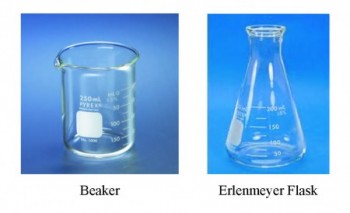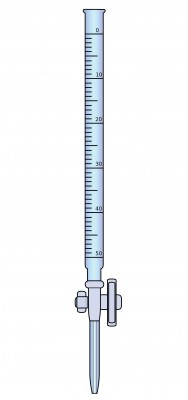Titration is a procedure frequently used to measure the chemical concentration in a liquid. The concept is pretty simple. A specific volume of the solution under test is collected and put into a container which is usually an erlenmeyer flask or a beaker.
The container can be glass, plastic or another material. Glass is often preferred because of its transparency. Marks on the flask or beaker are used to measure the precise amount of liquid. The Erlenmeyer flask offers a slight advantage in accuracy due to its tapered sides.
The size of the beaker or flask should be chosen to allow for more liquid to be added during the titration process. How much larger depends on the titration being performed. In most cases, the concentration of the liquid being added is adjusted so that a relatively small amount is required to produce the desired effect but it is a good idea to error on the high side.
Next, a burette is filled with a solution of known liquid concentration which, when it is mixed with the solution under test will produce a change in some observable or otherwise measurable property when the two are mixed in a precise ratio. The burette is usually glass so that the liquid inside can be easily observed. The numbers on the burette go “backward” with “0” at the top with numbers increasing as they go down the side of the tube. Arranged in this manner, they measure the amount if liquid that has been removed from the burette. This makes it simpler than subtracting once the titration is complete. There is a valve at the bottom of the burette. Turning this valve releases liquid from the burette in ranging from a “stream” to a single drop at a time. The burette should be filled to the “0” point at the start of the titration.
Finally, an “indicator” is added to the solution under titration that will indicate whatever property is desired at the end of the titration. In most cases, this indicator will change the color of the solution when the end point of the titration has been reached. Although all sorts of color changes can be used, one that is “dramatic” (such as turning the solution from red to clear) is preferred. Another indicator might be the change of the solution under test from cloudy to clear or vice versa.
During titration, liquid from the burette is added to the solution under test in the beaker or flask. This is done slowly so that the indicator change will not be missed. The trick is to add just enough but not too much of the solution from the burette to produce the desired change in the indicator. Adding too much will, of course, result in an inaccurate reading. It is also important to keep the solution in the beaker or flask totally mixed at all times. This can be done by “swirling” the liquid in the container, by stirring it with a glass rod, or by using a magnetic stirrer.
Once the desired indicator point has been reached, the number from the burette is recorded. Then, using a chart designed specifically for the test being conducted, the concentration of the original sample can be determined.
This blog covers the basic concept of titration. Most facilities have detailed instructions on how titrations should be performed which should be adhered to at all times. Also, many suppliers of cleaning chemistry provide titration “kits” which may include a small vial to collect the solution under test and some means (often an eye dropper) to deliver the calibrated titrant in precise amounts. In the case of the eye dropper, the number of drops of titrant required to produce the desired indicator change is used to determine concentration.
– FJF –



 English
English Spanish
Spanish Chinese
Chinese Canada
Canada Mexico
Mexico United Kingdom
United Kingdom





